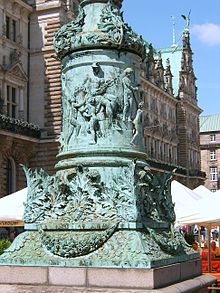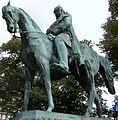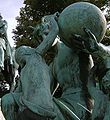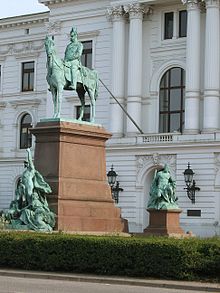Kaiser Wilhelm I Monument (Hamburg)

There are several Kaiser Wilhelm monuments in the Free and Hanseatic City of Hamburg . In honor of Kaiser Wilhelm I , who died in 1888 , many communities in the German Empire erected monuments. When the previously Prussian city of Altona was dissolved in Hamburg on April 1, 1937 by the Greater Hamburg Act, the Kaiser Wilhelm monuments were increased by an equestrian statue, among other things .
Monument in Hamburg

Coordinates: 53 ° 33 ′ 19.4 " N , 9 ° 58 ′ 41" E
The equestrian monument with a group of figures was designed by Johannes Schilling and unveiled on June 20, 1903 in the presence of the grandson Kaiser Wilhelm II on the Rathausmarkt in front of the Hamburg City Hall . Moved to Neustadt in 1930 , it has existed since 1997 in the current grouping in Planten un Blomen Park (corner of Johannes-Brahms- / Sievekingplatz / Holstenwall).
Emergence
Shortly after the death of Kaiser Wilhelm I in 1888, a commission made up of members of the Senate and the citizenship was commissioned to find the location and design of a monument, and it was in favor of a design by Fritz Schaper on the Reesendamm Bridge . However, the recommendation was not accepted by the citizens , who decided in 1890 for the installation on the Rathausmarkt. Traffic problems and financial questions prevented the implementation until the master builder of the town hall, completed in 1897, Martin Haller , rekindled the discussion and in 1898 (the equestrian monument in Altona was shortly before completion) a new decision on a monument design was made and implemented by Schilling. The design of the square is essentially based on the joint design by Carl Garbers and Ernst Barlach from a winning ideas competition, which Schilling merely adapted stylistically to his equestrian statue. The foundation stone was laid on June 3, 1902. The cost of the monument ensemble (including redesigning the square, relocating the tram, and celebrations) was over 1 million marks.
Original plant
On a raised plateau facing the town hall, the five and a half meter high equestrian statue stood on a six meter high, ornate base made of polished granite . Bronze reliefs to symbolize the unification of the empire in 1871 and the empire insignia were attached to this. The plateau (80 by 30 meters) was framed at the side by two separate, quarter-circle stone balustrades. Crowned by vase-like bronze fire basins, they too were provided on the inside with various reliefs relating to the unification of the empire and with surrounding benches, which were interrupted by several bronze griffins . The four allegorical groups of figures were also set up on the wide arched balustrades, which were closed off by the two flagpoles and two light masts. Two further light poles, whose bases were also adorned with ornaments from different German tree species, stood individually as light donors between the flag pole and the statue in the facility, which was also intended to serve as a fairground.
The monument deliberately represented the emperor in a dignified , simple uniform. The focus should not be on Prussian militarism, but on the social, economic and legal achievements after the founding of the German Empire and Hamburg's part in it.
Partial dissolution
In 1929/1930 the memorial, which had already been damaged during the November Revolution in 1918 and 1922 and was also criticized from the political side in the now democratic Weimar Republic , was removed. The reason was the redesign of the town hall market in 1930/1931 under the supervision of chief building director Fritz Schumacher , who wanted to remove the monument before the First World War in order to bring the square design back to the originally planned spatial structure (based on St. Mark's Square ). The equestrian statue, the allegorical groups, part of the balustrades and two lampposts were re-erected in front of the civil justice building (in front of the east facade in the ramparts on Holsten-, today Johannes-Brahms-Platz). The parts that are no longer used, such as the reliefs and attachments of the balustrades, are now considered lost. The flagpoles remained - moved closer to the town hall - at the old location.
The monument, which was damaged in World War II, was disbanded in 1961 due to the impending redesign of the ramparts (part of the Planten un Blomen park ) for the IGA in 1963 and the equestrian statue on a concrete base in the park was moved again.
The four groups of figures, which represent world traffic and the new means of communication, the new uniform imperial laws, the invalidity and old-age pension law and the uniform measurement and coinage, were shown after a brief exhibition from 1977 to 1980 on the Rathausmarkt in 1985 in front of the justice buildings on Sievekingplatz set up. In 1997 they were implemented again and now again grouped around the equestrian statue.
There is also a preserved light pole on St. Anscharplatz (backyard Neue ABC-Straße ) and the two side base reliefs of the statue in the shop windows of the "Thomas I Punkt" shop on Gänsemarkt and the back of the Hulbe-Haus .
Monument in Altona
Coordinates: 53 ° 32 ′ 51.1 ″ N , 9 ° 56 ′ 6.5 ″ E
In the city of Altona , a memorial for Kaiser Wilhelm I was also erected in front of the Altona town hall . Here, too, the statue is again an equestrian statue surrounded by other figures, but unlike later in Hamburg, directly in front of the north-facing main facade of the town hall with its back to Building was erected. The sculptor was Gustav Eberlein . The monument was inaugurated on June 18, 1898 in the presence of the (grand) imperial couple.
The equestrian statue of the emperor, depicted as a general with a helmet, stands on a high plinth. With his left hand he holds the reins of the horse. Before the base of the statue, an ancient warrior pose the German military strength and two female geniuses who hold each other's hands, the duchies of Schleswig and Holstein shows. On both sides behind the equestrian statue are on their own pedestals a blacksmith, standing for trade and industry and depicted a fisherman for trade and shipping .
More monuments in Hamburg
- The bust monument on Kaiser-Wilhelm-Platz in Hamburg-Bergedorf near the Bergedorf Palace .
- There is also a marble bust in the Kaisersaal of the Hamburg City Hall , in the place of which there was a larger than life ephemeral memorial (made of plaster) by Engelbert Peiffer to welcome the soldiers returning from the Franco-German War on June 17, 1871 . It was the first stately equestrian statue in the city republic and was also depicted on one of the lost bas-reliefs of the later Hamburg monument complex.
- A statue on a house facade at Friedenseiche / Willebrandstrasse in Hamburg-Altona
See also
- other Kaiser Wilhelm monuments in Germany
literature
- Reinhard Alings: Monument and Nation. The image of the nation state in the medium of monument - the relationship between nation and state in the German Empire 1871-1918. de Gruyter, 1996. inter alia. P. 224 ff.
- Johannes Schilling; The Kaiser Wilhelm monument in Hamburg. With explanations by the artist. [Issued in the Hamburg schools on March 22, 1905.]. Hamburg, Rademacher, 1905.
- Maik without time: "... to erect a worthy memorial to the founder of the empire." The Kaiser Wilhelm memorial in Bergedorf. In: Lichtwark book No. 72, pp. 43–46. HB-Werbung publishing house, Hamburg-Bergedorf, 2007. ISSN 1862-3549











